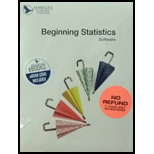
Construct and interpret a confidence interval for the true difference between the two population means.
Answer to Problem 16E
Solution:
The value of the margin of error is 10.1847 and 90% confidence interval for the true difference between the mean distance hit with the new model and the mean distance hit with the older model, is
Explanation of Solution
Given Information:
The number of balls by new bat or
| Hitting Distance (in Feet) | |
| New Model | Old Model |
| 235 | 200 |
| 240 | 210 |
| 253 | 231 |
| 267 | 218 |
| 243 | 210 |
| 237 | 209 |
| 250 | 210 |
| 241 | 229 |
| 251 | 234 |
| 248 | 231 |
It is assumed that the population variances must be equal.
Formula used:
The confidence interval for the difference between two population means for independent data sets is given by
Or
Where
and margin of error of a confidence interval for the difference between two population means is given by
Where,
Mean of the given observations is calculated as,
n is the total number of data given.
Calculation:
The margin of error for given populations is,
For populations where the variances are assumed to be equal, the number of degrees of freedom is calculated by substituting the value 10 for
Since the level of confidence is 90%, then level of significance is given as,
Substitute 0.1 for
For the t-distribution with 18 degrees of freedom, at 0.90 confidence level the
| S.no | New Model, |
Old Model, |
|
|
|
|
| 1 | 235 | 200 | -11.5 | -18.2 | 132.25 | 331.24 |
| 2 | 240 | 210 | -6.5 | -8.2 | 42.25 | 67.24 |
| 3 | 253 | 231 | 6.5 | 12.8 | 42.25 | 163.84 |
| 4 | 267 | 218 | 20.5 | -0.2 | 420.25 | 0.04 |
| 5 | 243 | 210 | -3.5 | -8.2 | 12.25 | 67.24 |
| 6 | 237 | 209 | -9.5 | -9.2 | 90.25 | 84.64 |
| 7 | 250 | 210 | 3.5 | -8.2 | 12.25 | 67.24 |
| 8 | 241 | 229 | -5.5 | 10.8 | 30.25 | 116.64 |
| 9 | 251 | 234 | 4.5 | 15.8 | 20.25 | 249.64 |
| 10 | 248 | 231 | 1.5 | 12.8 | 2.25 | 163.84 |
| Total |
For mean, substitute 2465 for
Similarly substitute 2182 for
For standard deviation, substitute 804.5 for
For standard deviation, substitute 1311.6 for
Substitute the values 2.101 for
The confidence interval is
Interpretation:
The 90% confidence interval for the true difference between the mean distance hit with the new model and the mean distance hit with the older model, ranges from 18.1153 to 38.4847.
Want to see more full solutions like this?
Chapter 9 Solutions
BEGINNING STATISTICS-CD (NEW ONLY)
 MATLAB: An Introduction with ApplicationsStatisticsISBN:9781119256830Author:Amos GilatPublisher:John Wiley & Sons Inc
MATLAB: An Introduction with ApplicationsStatisticsISBN:9781119256830Author:Amos GilatPublisher:John Wiley & Sons Inc Probability and Statistics for Engineering and th...StatisticsISBN:9781305251809Author:Jay L. DevorePublisher:Cengage Learning
Probability and Statistics for Engineering and th...StatisticsISBN:9781305251809Author:Jay L. DevorePublisher:Cengage Learning Statistics for The Behavioral Sciences (MindTap C...StatisticsISBN:9781305504912Author:Frederick J Gravetter, Larry B. WallnauPublisher:Cengage Learning
Statistics for The Behavioral Sciences (MindTap C...StatisticsISBN:9781305504912Author:Frederick J Gravetter, Larry B. WallnauPublisher:Cengage Learning Elementary Statistics: Picturing the World (7th E...StatisticsISBN:9780134683416Author:Ron Larson, Betsy FarberPublisher:PEARSON
Elementary Statistics: Picturing the World (7th E...StatisticsISBN:9780134683416Author:Ron Larson, Betsy FarberPublisher:PEARSON The Basic Practice of StatisticsStatisticsISBN:9781319042578Author:David S. Moore, William I. Notz, Michael A. FlignerPublisher:W. H. Freeman
The Basic Practice of StatisticsStatisticsISBN:9781319042578Author:David S. Moore, William I. Notz, Michael A. FlignerPublisher:W. H. Freeman Introduction to the Practice of StatisticsStatisticsISBN:9781319013387Author:David S. Moore, George P. McCabe, Bruce A. CraigPublisher:W. H. Freeman
Introduction to the Practice of StatisticsStatisticsISBN:9781319013387Author:David S. Moore, George P. McCabe, Bruce A. CraigPublisher:W. H. Freeman





